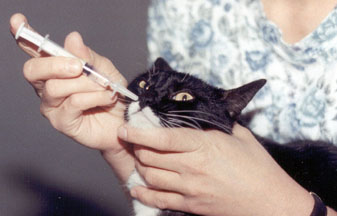
| An intranasal vaccine (Primucell) is available and has been shown to aid in protection against FIP infection. |
Causative Agent:
Feline infectious peritonitis (FIP) is caused by a corona virus. It is often characterized as having a wet (presence of fluid in the chest or abdomen) or a dry (no fluid) form. Cats between the ages of 6 months and 5 years seem to be the most susceptible, however, cats of any age may be affected. The wet form of FIP usually affects cats less than 2 years of age.Clinical Signs: The initial signs are often difficult to associate directly with FIP. These signs may include a fever, respiratory problems, discharge from the nose and eyes, and diarrhea. Cats with the wet form of FIP may have abdominal swelling or difficulty breathing depending on the location and amount of fluid accumulated. These symptoms can occur days, weeks, or months prior to dramatic signs of disease. Other signs which may occur as the disease progresses include involvement of the eyes (inflammation of the cornea, iris, and/or retina) and neurologic involvement such as tremors or seizure activity, incoordination, and behavioral changes.
As both forms progress, the cat may suffer from weakness, weight loss, a fever, and/or diarrhea which is often unresponsive to treatment. Death is the eventual result.
Some cats may eliminate the infection before showing any clinical signs while others may suppress the infection but not completely eliminate it. Those cats in the latter category tend to become virus carriers which never actually show any clinical signs of disease.
Disease Transmission: This virus is spread in contaminated saliva and feces from one animal to another. Infection occurs when an animal orally ingests contaminated feces or saliva. Mutual grooming, sharing of water and food bowls, and community litter boxes are probably the most common methods of transmission. Transmission of the FIP virus has also been shown to occur in the womb. It is unlikely that lice or fleas transmit the disease.
Diagnosis: Traditionally, diagnosing FIP has been extremely difficult. Testing for antibodies in the bloodstream against feline corona viruses has been available for many years, but because the FIP virus is only one of many feline corona viruses (most of which do not cause severe disease), this test has been difficult to interpret. Many cats have unfortunately been euthanized when mistakenly diagnosed with FIP after a positive test was obtained for a curable feline corona virus. Recently, a new test has been created called the FIP-specific ELISA which is able to differentiate the corona virus which causes FIP from other feline corona viruses. This test is a major breakthrough in the diagnosis of this serious disease.
Clinical signs are still an important part of making the diagnosis as well. In the wet form, evidence of fluid in the abdomen or thorax is a major indicator. This fluid can be sampled and then examined for the characteristic signs of FIP. A thorough examination of the eyes may also reveal important evidence supporting FIP infection.
Treatment: Once an animal has contracted this disease and developed clinical signs, there is no curative treatment. Supportive care is all that can be done and it may involve antiviral drugs, antibiotics for secondary bacterial infections, anti-inflammatory therapy, vitamin supplementaion, and pain relief. All cats with clinical FIP will eventually die of the disease. Animals that test positive, yet still show no signs of disease, should be continually monitored for disease progression. These animals should be kept in isolation to avoid exposure to other animals.
Prevention: An intranasal vaccine (Primucell) is available and has been shown to aid in protection against FIP infection. This vaccine has been shown to be 50-75% effective at preventing FIP corona virus from crossing the outer barrier in the mouth and nose where transmission takes place. If exposure has already occurred, Primucell is not effective at preventing the progress of the disease. Primucell should be administered in 2 doses, 3 weeks apart, beginning at 16 weeks of age.
Avoiding exposure to the virus is the best preventative. Indoor cats and cats in one- or two-cat households are at a lower risk for exposure to FIP.

|
|
|